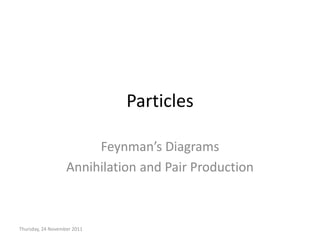
Feynman diagrams
- 1. Particles Feynman’s Diagrams Annihilation and Pair Production Thursday, 24 November 2011
- 2. Feynman’s Diagrams Richard Feynman designed a way to illustrate interactions between particles through exchange particles. His idea is simple: • Straight lines represent particles before and after the interaction • Wavy lines connect the straight lines and represent the particle exchange • The charge must be conserved at each junction • Particle lines point in the same direction for both attraction and repulsion • The direction of the lines does not show the direction of the particles
- 3. Electromagnetic Interactions The exchange particle responsible for electromagnetic interactions is a photon. So, Feynman’s diagrams for e- - e- and e- - p interactions are: After After e- e- e- p e- e- e- p Before Before electron – electron repulsion electron – proton attraction
- 4. - Decay In Beta decay a neutron in the nucleus decays (turns) into a proton, a fast moving electron ( -particle) and an anti-neutrino e n p e e Note that e- in this case is a fast moving electron ( -particle) emitted from within the nucleus through the decay of a neutron into a proton, and not an atomic electron that orbits around the nucleus.
- 5. Feynman’s Diagram for - Decay The force responsible for - decay is the weak force. So, the exchange particle is the W-. Draw Feynman’s diagram for this reaction. After p e- e W n Before The neutron decays into a proton releasing a W particle which very quickly decays into an -particle and an anti-neutrino.
- 6. + Decay In anti-Beta decay a proton in the nucleus decays (turns) into a neutron, a fast moving positron ( -particle) and a neutrino e p n e e
- 7. Feynman’s Diagram for + Decay The force responsible for + decay is the weak force. So, the exchange particle is the W+. Draw Feynman’s diagram for this reaction. After n e+ e W p Before The proton decays into a neutron releasing a W particle which very quickly decays into an -particle and a neutrino.
- 8. Electron Capture It is possible for a proton in the nucleus to “capture” an electron and turn into a neutron releasing a neutrino e p e n e
- 9. Feynman’s Diagram for e- capture The force responsible for electron capture is the weak force. So, the exchange particle is the W+. Draw Feynman’s diagram for this reaction. After n e W p e- Before The proton turns into a neutron by trapping an e-. The exchange particle W leaves a neutrino after the reaction.
- 10. Electron – Proton Collision When an electron and a proton collide the proton turns into a neutron releasing a neutrino e p e n e
- 11. Feynman’s Diagram for e- - p collisions The force responsible for this collision is the weak force. So, the exchange particle is the W-. Draw Feynman’s diagram for this reaction. After n e W p e- Before The proton turns into a neutron by colliding with an e-. The exchange particle W leaves a neutrino after the reaction.
- 12. Neutrino – Neutron Collisions When two particles collide they can give rise to new matter or cause the particles involved to change. If a neutrino e hits a neutron with sufficient Ek, the neutron turns into a proton and releases an electron. n e p e
- 13. Feynman’s Diagram e– n collision The force responsible for e – n collisions is the weak force. So, the exchange particle is the W+. Draw Feynman’s diagram for this reaction. After p e- W n e Before The neutron turns into a proton by colliding against a neutrino. The exchange particle W leaves an electron after the reaction.
- 14. Anti-neutrino – Proton Collisions When an anti-neutrino e hits a proton with sufficient Ek, the proton turns into a neutron and releases a positron (e+). p e n e
- 15. Feynman’s Diagram e– p collision The force responsible for e – p collisions is the weak force. So, the exchange particle is the W+. Draw Feynman’s diagram for this reaction. After n e+ W p Before e The proton turns into a neutron by colliding against an anti-neutrino. The exchange particle W leaves a positron after the reaction.
- 16. Annihilation When an anti-particle is created it can be observed, but only for a very short time. This is because: • It will soon collide against its particle • The two destroy each other • Their mass is converted in energy This process is called ANNIHILATION.
- 17. Annihilation Look at the annihilation of an electron and its anti-particle (positron) e- e+
- 18. Annihilation Why are two photons of energy produced and not just one? (Hint: any collision must obey all conservation laws) 0 0 0 1 e 1 e 2 0 • One photon only could conserve charge and mass/energy • But to conserve momentum two photons moving in opposite directions must exist
- 19. Pair Production A high energy photon like a -ray can vanish to form a pair particle – anti-particle. This is the opposite of annihilation and we call it PAIR PRODUCTION. e+ e-
- 20. Pair Production In what way would a third particle, e.g. nucleus or electron, get involved in this reaction? (Hint: again all conservation laws must apply) 0 0 0 0 1 e 1 e • The third particle recoils and carries away some of the energy of the photon • The recoil ensures that the momentum is also conserved
